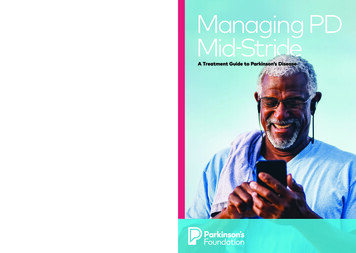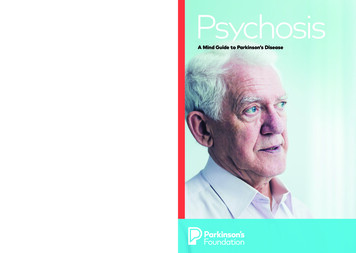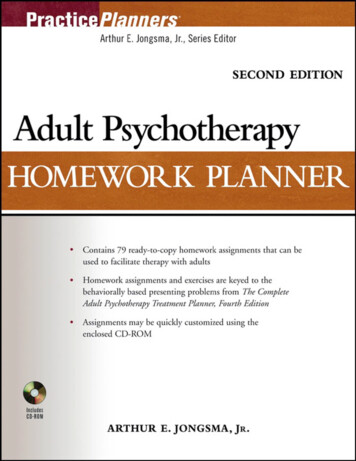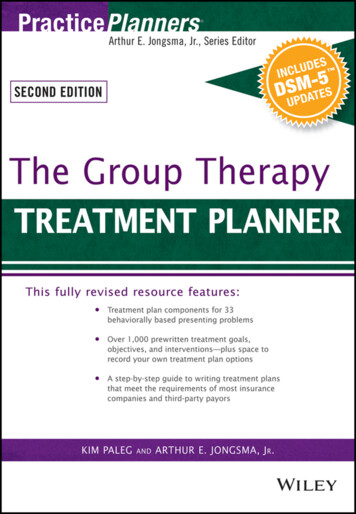
Transcription
A Treatment Guide to Parkinson’s Disease200 SE 1st Street, Suite 800Miami, Florida 331311359 Broadway, Suite 1509New York, New York 10018helpline:800. 4PD.INFO (473.4636)helpline@parkinson.orgparkinson. org
About the Parkinson’s FoundationThe Parkinson’s Foundation makes life better for people with Parkinson’sdisease by improving care and advancing research toward a cure.In everything we do, we build on the energy, experience and passionof our global Parkinson’s community. A wealth of information aboutParkinson’s and about our activities and resources is available on ourwebsite, Parkinson.org.Your feedback matters!We’d like to know what you think of our publications and programs.Please take a few moments to fill out our online feedback form.Your answers will be used to improve our resources and will benefitpeople with Parkinson’s, caregivers, families and others in theParkinson’s community. Thank you for your help.Online form:About this bookGlossaryDefinitions for all words underlined in blue canbe found in the glossary starting on page 36.A comprehensive Parkinson’s disease glossarycan be found at Parkinson.org/glossary.IndexAn index of key words and topics can befound on page 40.parkinson’s foundation resourcesThe Parkinson’s Foundation offers a variety ofresources to help you manage daily changes insymptoms and other issues related to Parkinson’s.In particular, check out the “Managing Parkinson’sMid-Stride” playlist at Parkinson.org/videos andthe “How to Manage Parkinson’s ‘Off’ Time”podcast episode at Parkinson.org/podcast.Parkinson.org/feedbackYour generosity makes this publication possible.The Parkinson’s Foundation is proud to provide this booklet and othereducational materials at no cost to people around the globe. If you foundthis book helpful, please consider a gift so that we may continue to fightParkinson’s on all fronts: funding innovative research, providing supportservices and offering educational materials such as this publication.Thank you for your support.Donate online:Parkinson.org/donateDonate by mail: Parkinson’s Foundation200 SE 1st St, Suite 800Miami, FL 33131Donate by phone:1-800-4PD-INFO (473-4636)Tax ID:13-1866796The information contained in this publication is provided for informational and educationalpurposes only and should not be construed to be a diagnosis, treatment, regimen or anyother healthcare advice or instruction. The reader should seek his or her own medical orother professional advice, which this publication is not intended to replace or supplement.The Parkinson’s Foundation disclaims any responsibility and liability of any kind inconnection with the reader,s use of the information contained herein. 2018
1Every person’s Parkinson’s disease (PD) journey is unique.No two people have exactly the same symptoms orprogression, let alone lifestyle and genetics. However, itis common that once you begin a treatment regimen afterdiagnosis, you can live life for a while with nearly completerelief from symptoms and few side effects. Eventually,though, after several years of being treated with levodopa,many people with PD notice that controlling symptomsbecomes more difficult and requires more medication.At this pointt, motor fluctuations (also called “on-off”fluctuations) may begin to appear.This book explains what motor fluctuations are, why these changes mighthappen and how to treat and cope with them. The information, tips andstories included here will provide answers, help you organize thoughts andquestions for your medical team and remind you that you are not aloneon this Parkinson’s journey.
2ContentsAboutParkinson’sDisease5PD Mid-Stride7Exercise26TalkingAbout PD29
3Treatment12Non-MotorFluctuations24Appendix 34Glossary 36Index 40Hope31
4AcknowledgementsThis book was written and reviewed by:Cindy Zadikoff, MD, MScNorthwestern UniversityFeinberg School of MedicineYasaman Kianirad, MDUniversity of Illinois at ChicagoGiselle Petzinger, MD, Beth Fisher, PT, PhD,Lauren Hawthorne and Michael Jakowec, PhDat Keck School of Medicine of the University ofSouthern California, contributed informationon exercise and cognition.This book has been made possible through thegenerous donations of thousands of individualsaffected by Parkinson’s and grants from:Design: Ultravirgo
5chapter oneAbout Parkinson’sDiseaseIf you’re reading this book, you are probablyalready familiar with Parkinson’s disease, buthere are some basics: Parkinson’s is a progressiveneurodegenerative disorder that affects about onemillion people in the United States and 10 millionpeople worldwide. It is called a movement disorderbecause of the tremors, slow movements, stiffnessand muscle cramping it can cause. But its symptomsare diverse and usually develop slowly over time.Parkinson’s disease is not diagnosed with a test or a scan; instead it isdiagnosed by a neurologist, who asks you questions about your healthand medical history and observes your movement. Your doctor maywant you to have some tests or imaging; some, like an MRI, can helprule out other conditions, while others, like DaTScan, may help confirm aParkinson’s diagnosis if there is uncertainty. The goal of treatment is tohelp you manage your symptoms. Good symptom management can helpyou to stay healthy, exercise, and keep yourself in the best possible shape.Although at this time there is no way to correct the brain changes thatcause Parkinson’s, we know that exercise can help you maintain your ability
6Managing Parkinson’s Mid-Strideto fight the disease and that staying healthy can reduce setbacks that makePD progress faster. Great care is an important part of living your best lifewith Parkinson’s.Lack of dopamine in people with Parkinson’s was first described in the 1960s.Dopamine is a type of neurotransmitter, or chemical messenger, one ofseveral chemicals your brain cells use to send signals to one another. Soonafter, dopamine-replacement therapy using levodopa became – and remains– the gold standard treatment. However, we know that the dopamine systemis not the only one affected by Parkinson’s. The disease process also disruptsother brain networks, including those linked to mood, behavior and thinking(cognition). You might also hear that Parkinson’s is linked to a protein in thehuman brain called alpha-synuclein. Researchers continue to study how cellsand brain networks are affected in Parkinson’s to improve our understandingof the disease and potential for treatments.You and your family may have questions or fears about Parkinson’s andgenetics. While there are several genetic mutations that can increase yourrisk, for the vast majority of people, Parkinson’s is not inherited. There is notest that can accurately predict who will develop Parkinson’s. Extensive geneand biomarker research is underway to uncover the possible factors involvedin – not necessarily causes of – disease development.
7chapter twoPD Mid-StrideYou probably experienced a range of emotions upon hearingthe words, “You have Parkinson’s disease.” In addition tofear, confusion or anger, relief might have been one of them.For months, if not years, you might have been nagged by thequestion, “What’s going on with my body?” You or a loved oneprobably noticed a tremor, slowness or stiffness and spoketo a doctor about it. The doctor – or maybe it took severaldoctors – probably referred you to a neurologist. Now you havetreatment options to improve your symptoms. You and yourhealthcare provider might have decided to start medicationright away, or you might have waited a bit, focusing onexercise to manage your symptoms.
8Managing Parkinson’s Mid-StrideAfter beginning treatment, whatever symptoms and complaints that led youto the doctor in the first place probably improved greatly. In these first fewyears of treatment, usually with easy-to-take Sinemet (carbidopa-levodopapills) or other medications, people generally enjoy nearly complete relief fromsymptoms with minimal side effects. During this time, you have smoothtransitions between doses. It is necessary to rely on a clock to tell you whenit is time to take the next dose of medication because there is no return ofsymptoms between one dose of levodopa and the next. Medications allowyou to go about your life, participating in work, hobbies and social activitiesas you did before Parkinson’s.After several years of being treated with levodopa, many people with PDnotice that controlling symptoms becomes more difficult and requiresmore medication, but you can still live a good life.What Are Motor Fluctuations and Dyskinesias?Motor FluctuationsMotor fluctuations are changes in your ability to move. They are also called“on-off” fluctuations. When levodopa begins to take effect, you experienceperiods of good symptom control (“on” time), when you can move and functionwell. As levodopa begins to lose its effect (“wearing off”), you may haveperiods in which symptoms are suddenly much more noticeable and movementbecomes more difficult (“off” time). You might even have periods in whichpeak medication levels produce involuntary movements (dyskinesias). If youexperience these various states throughout the day, you are said to havemotor fluctuations.Usually, when you first develop wearing off, the switch from “on” to “off”happens gradually. “Off” periods initially are predictable and occur near the endof each medication dose. For example, when they first begin treatment, manypeople are placed on a regimen of carbidopa-levodopa three times a day. Earlyon, as we described above, the medication lasts dose to dose, but over timethe medication may begin to wear off 30 minutes to an hour before the nextdose. At this point, you notice a gradual return of symptoms. As Parkinson’sprogresses, levodopa stays effective for shorter periods of time. This meansyou have to take more frequent doses, and “off” episodes may become moresudden and/or unpredictable.
pd mid-stride9For some people the first sign of an “off” period is a return of motor symptoms– tremor, stiffness or slow movement. For others, non-motor symptomsmight creep in. This could include a range of complaints, such as pain, anxiety,fatigue, mood changes, difficulty thinking, restlessness, sweating or drooling(from decreased swallowing). Since non-motor symptoms can be subtle in thebeginning, it may be difficult at first to link them to a change in the effect ofyour PD medication.DyskinesiaDyskinesias are involuntary movements: they are often fluid and dance-like,but they may also cause rapid jerking or slow and extended muscle spasms.Any part of the body may be involved, including the face, arms, legs and trunk.The most common kind of dyskinesia is “peak dose.” This occurs when theconcentration of levodopa in the blood is at its highest – usually one to twohours after you take it. This typically matches up with when the medicationsare working best to control motor symptoms.Sometimes, instead of at peak dose, dyskinesias can occur as you are justbeginning to turn “on” and again as you begin to turn “off.” This is knownas diphasic dyskinesia, or the dyskinesia-improvement-dyskinesia (D-I-D)syndrome. Diphasic dyskinesias are associated with relatively low doses oflevodopa and, unlike peak-dose dyskinesias, tend to improve with higherdoses of levodopa.Dyskinesias may be mild and non-bothersome, or they can be severe.In some people, dyskinesias can have a big impact on activities of daily living,making it more difficult to get dressed, eat, perform hygiene tasks, exerciseand participate in your favorite hobbies. Dyskinesias can also have a socialand emotional impact. However, most people with PD prefer to be “on” withsome dyskinesias rather than “off” and unable to move well.
10 Managing Parkinson’s Mid-StrideJohn was diagnosed with Parkinson’s in 1997, and in early 2002 he hadhis first episode of dyskinesia. I usually describe it to people as a rapidmisfiring of his nerves, and in John’s case, it caused very violent shakingand misfiring. We could watch the clock and after exactly four hours,it would subside. Initially, it only happened every couple of months.Then it increased to once a week, then once a day, then sometimesa couple of times a day. As his wife, it was alarming to watch. – DonnaOther Common IssuesDystoniaDystonia is when your muscles continuously contract, causing parts of yourbody to twist. This leads to repetitive movements or abnormal postures andcan cause great pain and discomfort. Many times it starts when you tryto perform an action with the involved body part. For example, if you havedystonia of the foot, you may be fine when seated, but if you start to walk,you may develop toe curling or foot inversion (turning in of the foot or ankle).Dystonia can also be present when you are not using the involved body part;in the example above, you could have toe curling even when sitting.In Parkinson’s disease, dystonia can occur at different times. In young peoplewith PD, a common initial symptom is cramping or curling of the toes andfeet after activity. Like dyskinesia, dystonia may occur at peak dose (whenthe medication is working at its best), and it is sometimes the earliest signof dyskinesia. More commonly, dystonia occurs when dopamine levels arethe lowest (“off” periods) or when the medications are just starting to kickin. This means some people experience dystonia first thing in the morning, asnighttime medications are wearing off and before they take their first daytimedose. Sometimes dystonia can persist intermittently throughout the day, andmay not correlate with timing of medications at all.It is important to keep track of when dystonia occurs, to figure out if thereis a relationship between the onset of dystonia and the timing of yourmedication. Talk to your doctor. If there is a pattern (keep track using theParkinson’s Symptoms Diary on pages 18–19), adjusting the dose or frequencyof medication may help.
pd mid-stride 11FreezingAs Parkinson’s advances, it may bring with it a variety of symptoms that areuncommon in early stages, such as problems with walking (gait abnormalities)and poor balance (postural instability). Some people experience “freezing,”the temporary, involuntary inability to move. This can occur at any time – forexample, you want to walk forward but your feet feel stuck to the ground(called “freezing of gait”), or you may be unable to get up from a chair.Some freezing happens when you are due for the next dose of dopaminergicmedication. This is called “off” freezing. Usually, the freezing episodes lessenafter taking your medication.The first time I froze, I fell. I couldn’t believe it. It was like I had cementboots on and couldn’t raise my feet. I reported it to my doctor, and sheadded a dopamine agonist to my regimen. I still have freezing episodesfrom time to time, but not as much. When I have an episode, I try toshift my weight from leg to leg. This helps. Also, I always turn in a squareinstead of trying to do a pivot turn. I also notice that I’m more likelyto freeze at doorways when the floor surface changes, so I’m extracareful then. – ErikaFreezing (feet glued to floor) is a significant cause of falls.Freezing often happens while turning around in close quarters. Try toavoid tight turns whenever possible. Instruct the person with Parkinson’sto make wider turns.If the person has a freezing episode while trying to walk, encourage himor her to stop, straighten posture and shift weight to one foot beforebeginning to step with the other.To help with freezing, count or clap a rhythmic beat.Some people who experience freezing episodes do better with a visualcue, such as “step over my foot.”Tip SheetTips for Caregivers
12chapter threeTreatmentMotor fluctuations and dyskinesias tend to develop at aboutthe same time in the disease course. Early in the disease, thebenefits of levodopa can last for several hours. The length ofeffect depends on the half-life of the drug (the time it takesfor your body to process the drug in your blood) and otherindividual factors like body composition and dietary intake.For carbidopa-levodopa, the half-life is about 60–90 minutes,but “on” time can last much longer. This is most likelybecause some levodopa is still stored in the remainingdopamine-producing brain cells. So, when you first starton levodopa therapy, you take it only a few times a day andcan smoothly transition from one dose to the next withouta return of symptoms in between doses.
13As Parkinson’s progresses, more dopamine-producing brain cells die, and thebenefits from a dose of levodopa do not last as long. Your brain eventuallyreaches a point where it stops producing dopamine in any significant amount,so it must rely on medicine to replace dopamine, such as levodopa anddopamine agonists. When this happens, scientists think that two thingsare going on: First, the cells in your brain lose the ability to store some of thelevodopa, and you don’t get a benefit when it is not present in yourblood (i.e., after 60-90 minutes); and Second, the cells in your brain become more and more sensitive toboth higher and lower concentrations of levodopa, making you morelikely to experience “off” time when your blood levels are low and toexperience dyskinesia when your blood levels are high.So, as these changes happen in your brain, you will have to take more dosesthroughout the day to avoid the return of symptoms, such as tremor, slownessand shuffling gait.For a few years, my medication was working great! People didn’teven know that I had Parkinson’s. Then gradually my symptomsstarted to come back sooner than the time I was supposed to takemy next pill. I was really anxious at first, but with some medicationadjustments and increasing my dosages, my doctor was able toput me back on track. – KenHow Will My Doctor Work with Meto Manage These?The “therapeutic window” describes the period of time when a medication iseffective. There is enough medication in your body to control your symptoms,but not too much so that side effects occur. Good medication responseoccurs within the window – outside the window, you might get motorfluctuations (not enough medication) or dyskinesias (too much). “Off”periods and dyskinesias tend to increase in frequency and severity asthe disease progresses. See figures on next page.
14 Managing Parkinson’s Mid-StrideThe figures here, based on insights from the Parkinson’s Foundation’sParkinson’s Outcomes Project, the largest-ever clinical study of Parkinson’s,illustrate how levels of dopamine in your brain change and how your bodyreacts to those changes as Parkinson’s progresses.DOPAMINE LEVELSTHE BASIC MODELTIME (hours).5Medication Effect(blue line)The blue curverepresents how wethink the level ofdopamine in thebrain changes afteryou take medication:levels rise, youmetabolize the drug,then levels decline.11.5Therapeutic Window(white area)The goal is to getdopamine levelsinto the “therapeuticwindow.” When levelsare here, you don’tfeel the absence ofdopamine. However,you might still havesymptoms, especiallylater in the disease.2DOPAMINE LEVELS11am1pm3.54“Off” Symptoms(light blue area)After you take yourpill(s), as your bodymetabolizes thedopamine at theend of the dose,you may experience“wearing off,”leading to “off”episodes. Thishappens laterin the disease.Dopamine Levels (black line)Natural (or “endogenous”) dopaminelevels stay within the therapeutic window.Wide Therapeutic Window9am3Dyskinesia (dark blue area)If you get too muchdopamine, you mayexperience dyskinesia:writhing motions thatare difficult or impossibleto control. Usually we saythat these go away whenyou get back into thetherapeutic window,but they might actuallypersist for a bit even afterdopamine levels go down.BEFORE PARKINSON’S7am2.53pm5pm7pm9pm11pm
treatment 15EARLY PARKINSON’SDOPAMINE LEVELSSome “off” before first dose,with breakfast at 8 am.7am9am11amSecond dose with lunch atnoon, with no “off” experienced.1pm3pm5pmA late dinner results in some mildafternoon “off” as the lunch doseis metabolized.7pm9pm11pmNatural dopamine levels (black line) are below the therapeutic window(white area), resulting in “off” (light blue) without medications.MID-STAGE PARKINSON’SEarly morning “off” is bad before first dose at 8 am. Some peopleset an early alarm to take pills before they get up for the day.You might also use an alarmto keep on schedule, whichcan work pretty well.DOPAMINE LEVELSMild dyskinesia7am9am11am1pm3pm5pm7pm9pm11pmNatural dopamine levels (black line) are well belowthe therapeutic window (white area), resulting in prettysevere “off” state (light blue area) without medications.ADVANCED PARKINSON’SSome people need a fast-acting “rescue”medication to jumpstart their day.Mid-day offBecause the therapeutic window is so narrow,dosing intervals can be as short as 2 hours.DOPAMINE LEVELSMild dyskinesia7am9am11am1pm3pmNatural dopamine (black line) is low.5pm7pm9pm11pm
16 Managing Parkinson’s Mid-StrideThe goal of managing motor fluctuations and dyskinesias, like the goal fortreatment of any symptom, is to help you remain as active and independentas possible. If your symptoms are mild and not bothersome, no changes needto be made to the medication regimen. But if these symptoms start to impactyour daily functioning or quality of life, you can work with your physician toadjust medications. When people first begin to experience these complications,there is a relatively wide therapeutic window (see “Early Parkinson’s” on theprevious page). Motor fluctuations can often be reversed by increasing thedose of levodopa or incorporating other Parkinson’s medications withoutinducing troublesome dyskinesias.Management of Motor FluctuationsDepending on what medications you are already taking, there are severalapproaches your doctor can take to help smooth out your response tomedications to avoid or minimize fluctuations.Your doctor can adjust your dose of levodopa, either by giving you a higherdose each time you take your medication, or by giving you the same dose ora smaller dose more frequently. Your doctor may add different medicationsto your current regimen. There are several medications that can be takenalong with carbidopa-levodopa. These help keep levels of dopamine moreconsistent to avoid “off” time. All of these medications have the same end goal– increasing dopamine in the brain – but they work differently on the body andbrain. For this reason, the options are not mutually exclusive and often canbe tried together.Treatment options include the following (see Appendix on page 34 for a listof typical Parkinson’s medications and a pronunciation guide): Increase the levodopa dose or frequency of administration Add a COMT inhibitor (i.e., entacapone or tolcapone) Add a dopamine agonist (i.e., ropinirole, pramipexole, rotigotine) Add an MAO-B inhibitor (i.e., selegiline, rasagiline) Switch from immediate-release (IR) carbidopa-levodopa to extended-release(ER) carbidopa-levodopa or to a combined preparationNOTEFor more information, order your free copy of the book Medications from theParkinson’s Foundation by calling our Helpline at 1-800-4PD-INFO (473-4636)or online at Parkinson.org/books.
treatment 17A controlled-release formulation of carbidopa-levodopa (Sinemet CR) isavailable. It was designed to extend the benefits you get from the same doseof carbidopa-levodopa and possibly decrease the number of pills neededper day. However, studies have shown that people who take the immediaterelease version and those who take the controlled-release form have aboutthe same number and frequency of motor complications. Furthermore, the CRversion can take longer to take effect than regular carbidopa-levodopa andit is not always well absorbed into the blood. For these reasons, it is perhapsmost valuable in treating wearing off effects that occur overnight.Extended-release carbidopa-levodopa capsules (Rytary) are a newer attemptto deliver levodopa so that it lasts longer. These capsules contain bothimmediate- and extended-release carbidopa-levodopa. This design allowsrapid absorption of part of the dose but slower absorption of the rest andtherefore maintains levodopa concentrations longer than immediate-releaselevodopa alone. This form of levodopa may reduce “off” time while requiringfewer medication administrations.It is worth mentioning that carbidopa-levodopa can be obtained as an orallydisintegrating (melt in your mouth) form (Parcopa). This can be useful ifyou struggle to swallow pills. As an alternative, Sinemet may be chewed(immediate-release only; do NOT chew controlled-release).Another option, rather than adding more medications or taking medicationsmore frequently, is to use an on-demand or as-needed approach. There areseveral short-acting dopamine replacement medication options available orin development that can be used as “rescue” therapy in people experiencing“off” episodes. They are designed to take effect quickly: within 15 minutes orless. Typically, the response is short, maybe an hour or two. It is called “rescue”therapy because it bridges gaps in other medication effectiveness. “Rescue”medications can be effective for people who struggle with morning akinesia(inability to move or slowness of movement) or who experience an unexpectedor inconvenient “off” episode. At the time of this writing, there is only one suchmedication approved in the U.S., but others are on their way (see page 20).
18 Managing Parkinson’s Mid-StrideworksheetParkinson’s Symptoms DiaryMany symptoms of Parkinson’s can be bothersome andinterfere with day-to-day quality of life. Patient and familyobservations can help the medical team make a care plan.Fill out this worksheet and share it with providers to see ifthere is a pattern to when Parkinson’s symptoms occur.TIMEMEDICATIONMEALSLEEP
treatment 19List the symptoms you want to track – e.g., tremor, dyskinesia, anxiety – in the top row. When those symptoms occur, fill in the number that corresponds to the severity at that time. Write medication names and doses next to the times at which you take them. Put an X (or list foods) in the “Meal” column at mealtimes. Put an X in the “Sleep” column when you sleep.0 NONE1 SLIGHT OR MILD2 MODERATE, BOTHERSOME3 SEVERE, VERY BOTHERSOMESYMPTOMSList 012301230123012301230123
20 Managing Parkinson’s Mid-StrideCurrent and potential “rescue” medications: Apomorphine (Apokyn) is an FDA-approved, short-acting dopamine agonistthat can be used as “rescue” therapy. It is delivered via a subcutaneousinjection, similar to an insulin shot or EpiPen, whichallows for it to take effect quickly: within 3.5 to 12.5 minutes. A sublingual (absorbed under the tongue) strip of apomorphineis currently being studied. A powder aerosol inhaled formulation of levodopa (similar to inhalersused to treat asthma) is also being studied.Management of Peak-Dose DyskinesiaPeak-dose dyskinesias occur at the time when levodopa is working best – whenlevodopa is at its highest concentration in the blood. In the earliest stages,they are usually not bothersome, and you may not even notice these extramovements. Because they tend to occur at peak concentrations of levodopa,one management strategy is to reduce dopamine levels. This can be donewith small decreases in levodopa dosage or by removing other dopaminergicmedications (e.g., dopamine agonists, COMT inhibitors or MAO-B inhibitors).However, as Parkinson’s progresses, if you reduce the levodopa dose, yourParkinson’s symptoms will not be well controlled. Amantadine is a medicationthat may be added to your medication regimen to reduce dyskinesias withoutworsening “off” periods. The U.S. Food and Drug Administration has approvedan extended-release formulation of amantadine (brand name Gocovri)specifically for the treatment of levodopa-induced dyskinesia in people with PD.Other amantadine formulations are sometimes used off-label for dyskinesia.Management of DystoniaDepending on when dystonia occurs, your doctor may try different approachesto treatment. If you have morning dystonia, which occurs before your first doseof levodopa kicks in, your physician may add a bedtime dose of controlledrelease carbidopa-levodopa or a long-acting dopamine agonist.If dystonia is related to diphasic dyskinesia (i.e., as the medications arewearing off or before they begin working), increased doses of levodopa orsmaller doses more frequently may be useful. On occasion, oral medicationsto treat spasms, such as anticholinergic medications, can be tried, but thesecan cause significant mental and physical side effects, so their use should becarefully considered.
treatment 21If other measures fail and your dystonia doesn’t correlate with levodopa timing,you and your healthcare provider may consider botulinum toxin injections.Botulinum toxin weakens muscles. By targeting the overactive muscles, yourphysician can improve both the abnormal position and the pain caused bydystonia. It can take several injections to optimize benefit and may not alwaysbe effective, but when it works the benefit can last for several months before itwears off and re-injection is necessary. Botulinum toxin A (Botox) is sometimesused to decrease saliva production for people who have issues with drooling;botulinum toxin B (Myobloc) is used to treat dystonia. Xeomin and Dysport aretwo other brand name forms of botulinum toxin that can be safely used in thetreatment of dystonia.What Next?With advancing disease, there is a further narrowing of the therapeuticwindow. For some people, it can become increasingly difficult to find a doseof levodopa that is both effective and does not cause dyskinesia. As welearned above: If you increase medications in an attempt to improve “off” time, it maylead to worsening dyskinesia. If you decrease medications in an attempt to improve dysk
PD progress faster. Great care is an important part of living your best life with Parkinson’s. Lack of dopamine in people with Parkinson’s was first described in the 1960s. Dopamine is a type of neurotransmitter, or chemical messenger, one of several chemicals your










